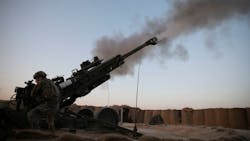Defense Department Defines Weapon Effects on Brain
Hoping to ensure healthy brains for military troops, the U.S. Department of Defense (DoD) established guidelines for operating distances from weapons systems, such as howitzers and mortars (see image above), and their release of pressure during use.
The policy memorandum, which is part of the brain health initiative, was signed by Deputy Defense Secretary Kathleen Hicks. It sets acceptable standoff distances for specific weapons systems, established monitoring of personnel exposed to blast overpressure (BOP), and considers the effects of new weapons systems on brain health.
As Hicks noted in the memorandum, “The department is committed to advancing combat readiness while reducing risks associated with blast overpressure.” The memorandum seeks to protect the brain health of DoD personnel without undermining training efforts on advanced weapons systems.
Hicks explains, “This policy is not meant to preclude or unreasonably restrict commanders from conducting mission-essential weapons training. Rather, this policy establishes requirements for practical risk management actions to mitigate and track BOP exposures across the DOD.”
The new policy aims at establishing operating distances during training for numerous weapons systems as part of BOP management. It hopes to enhance education of civilian and military personnel on weapons systems with BOP requirements; identify and track all DoD personnel who are at the highest risk when using those weapons systems; and establish practical methods for maintaining safe operating distance to minimize the effects of BOP from specific weapons systems.
Kathy Lee, director of the Department of Defense policy for warfighter brain health, said, “Blast overpressure is the wave that's experienced after firing a weapon or munition. When this wave occurs, there can be impacts that affect cognition, balance changes, and other potential brain health issues.”
As a threat to brain health, BOP can be generated by smaller as well as larger weapons systems, including shoulder-mounted M72 light anti-armor weapons, M136 light antitank weapons, and MK15 sniper rifles. Weapons causing BOP concerns were identified in the memorandum after consultation with military services.
About the Author
Jack Browne
Technical Contributor
Jack Browne, Technical Contributor, has worked in technical publishing for over 30 years. He managed the content and production of three technical journals while at the American Institute of Physics, including Medical Physics and the Journal of Vacuum Science & Technology. He has been a Publisher and Editor for Penton Media, started the firm’s Wireless Symposium & Exhibition trade show in 1993, and currently serves as Technical Contributor for that company's Microwaves & RF magazine. Browne, who holds a BS in Mathematics from City College of New York and BA degrees in English and Philosophy from Fordham University, is a member of the IEEE.

